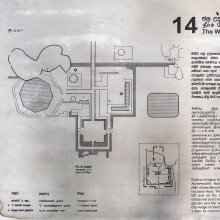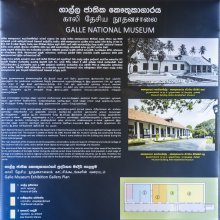Avenika, Āveṇika: 8 definitions
Introduction:
Avenika means something in Buddhism, Pali, Hinduism, Sanskrit. If you want to know the exact meaning, history, etymology or English translation of this term then check out the descriptions on this page. Add your comment or reference to a book if you want to contribute to this summary article.
Images (photo gallery)
In Buddhism
Mahayana (major branch of Buddhism)
Source: Wisdom Library: Maha Prajnaparamita SastraĀveṇika (आवेणिक) or Āveṇikadharma refers to the “eighteen special attributes”, according to the 2nd century Mahāprajñāpāramitāśāstra chapter 40.—Accordingly: The Buddha utters the lion’s roar. He is like the king of the lions (siṃharāja). [...] The Buddha-lion is very similar. [...] The four right efforts are his strong chin. The thirty-seven auxiliaries of enlightenment are his sharp teeth, joined and pointed. The practice of the meditation on the horrible is his pink tongue. Mindfulness and wisdom are his pricked-up ears. The eighteen special attributes (āveṇika-dharma) are his dazzling shiny mane. [...]
Source: academia.edu: A Study and Translation of the GaganagañjaparipṛcchāĀveṇika (आवेणिक) refers to the “(eighteen) special qualities (of the Buddha)”, according to the Gaganagañjaparipṛcchā: the eighth chapter of the Mahāsaṃnipāta (a collection of Mahāyāna Buddhist Sūtras).—Accordingly, “Then the Bodhisattva Gaganagañja, having praised the Lord with these verses, addressed himself to the Lord: ‘[...] Since the Lord has obtained intrepidities, extinguished contamination, was perfectly awakened to sameness (samatā), is skilled in the knowledge of purification without affliction, and roars the best of lions’ roar to all of the world including the gods. Since the Lord is endowed with the eighteen special qualities of the Buddha (aṣṭa-āveṇika-buddhadharma-samanvāgata), he has the unattached knowledge of the three times (trikāla). Since the Lord has purified his body, speech, and mind, he has neither error (skhalita) nor rough speech (ravita), and sees every concentration (samāpatti) and the knowledge of liberation. [...]’”.

Mahayana (महायान, mahāyāna) is a major branch of Buddhism focusing on the path of a Bodhisattva (spiritual aspirants/ enlightened beings). Extant literature is vast and primarely composed in the Sanskrit language. There are many sūtras of which some of the earliest are the various Prajñāpāramitā sūtras.
Languages of India and abroad
Pali-English dictionary
Source: BuddhaSasana: Concise Pali-English Dictionaryāveṇika : (adj.) special; exceptional; separate.
Source: Sutta: The Pali Text Society's Pali-English DictionaryĀveṇika, (adj.) (fr. āveṇi; cp. BSk. āveṇika Av. Ś I. 14, 108; Divy 2, 182, 268, 302) special, extraordinary, exceptional S. IV, 239; A. V, 74 sq. ; Vism. 268; VvA. 112 (°bhāva peculiarity, specialty), KhA 23, 35. (Page 113)

Pali is the language of the Tipiṭaka, which is the sacred canon of Theravāda Buddhism and contains much of the Buddha’s speech. Closeley related to Sanskrit, both languages are used interchangeably between religions.
Sanskrit dictionary
Source: Cologne Digital Sanskrit Dictionaries: Edgerton Buddhist Hybrid Sanskrit DictionaryĀveṇika (आवेणिक).—adj. (= Pali id. or °ṇiya; [etymology] obscure; see also āveṇīya, āvedanika, and Konow, Avhandl. Norske Viden. Akad. 1941, II. Hist. -Fil. Kl., p. 41), peculiar, individual, particular, special: Divyāvadāna 2.3 (a cliché, practically identical with Avadāna-śataka i.14.7 etc.) pañcāveṇikā dharmā ekatye paṇḍitajātīye mātṛgrāme, there are five peculiar characteristics in every intelligent woman (listed in the sequel); Divyāvadāna 302.24 °kā ime svārthā anuprāpto bhaviṣyāmi, I shall have attained these special purposes of mine (iti saṃpaśyatā paṇḍitenālam eva pravrajyādhimuk- tena bhavitum); Mahāvastu iii.320.6 ye te sattvā āveṇikā bha- vanti, evaṃrūpāḥ sattvā (sc. Buddhas, special creatures) āryadharmacakraṃ pravartenti; there are three āveṇika smṛtyupasthāna (q.v.) in a Buddha, Divyāvadāna 182.20; Avadāna-śataka i.7.5; listed Mahāvyutpatti 187—190; (referred to without the adjective āveṇika, Asaṅga (Mahāyāna-sūtrālaṃkāra) xx.53; Abhidharmakośa La V-P. vii.76;) espe- cially used of the 18 āveṇika buddhadharma of a Buddha, listed Mahāvyutpatti 135—153 (Tibetan ma ḥdres pa, unmixed, un- adulterated, pure); the list here is, (1) nāsti tathāgatasya skhalitam, (2) nāsti ravitam, (3) nāsti muṣitasmṛtitā (or °tiḥ), (4) nāsty asamāhitacittam, (5) nāsti nānātvasaṃjñā, (6) nāsty apratisaṃkhyāyopekṣā, (7) nāsti chandasya hāniḥ, (8) nāsti vīryasya hāniḥ, (9) nāsti smṛtihāniḥ, (10) nāsti samādhihāniḥ, (11) nāsti prajñāyā hāniḥ, (12) nāsti vimuktihāniḥ, (13) sarva-kāya-karma jñānāpūrvaṃ- gamaṃ jñānānuparivarti, (14 and 15) id. with vāk, manaḥ, for kāya, (16—18) atīte (17 anāgate, 18 pratyutpanne) 'dhvany asaṅgam apratihataṃ jñānadarśanaṃ pravartate; similarly Mahāvastu i.160.8 ff. (here they constitute the 5th cak- ṣuḥ, q.v., viz. buddha-c°); Mahāvyutpatti 1—6 = Mahāvastu 13—16, 18, 17; Mahāvyutpatti 7—12 = Mahāvastu 7—12; Mahāvyutpatti 13—15 = Mahāvastu 4—6; Mahāvyutpatti 16—18 = Mahāvastu 1—3; Dharmasaṃgraha 79 (substantially as in Mahāvyutpatti; two obvious errors); in Asaṅga (Mahāyāna-sūtrālaṃkāra) xx.57 commentary (before the verse called āveṇika guṇa, but after it āv° buddhadharma) divided into groups, called six cāra-saṃgṛhīta āv° bu° (= Mahāvyutpatti 1—6), six adhigama-saṃgṛhīta (= Mahāvyutpatti 7—12), three jñāna-saṃgṛhīta (= Mahāvyutpatti 16—18), three karma- saṃgṛhīta (= Mahāvyutpatti 13—15); Burnouf, Lotus Appendice IX, cites a late Pali list from the Jinālaṃkāra, which substan- tially agrees in order with that of Mahāvastu (but the category is unknown to older and genuine Pali Buddhism, compare Konow, l.c. above); references to the 18 āv°(bu°)dh°, Saddharmapuṇḍarīka 62.4; 259.5; Lalitavistara 160.15; 275.10-11 (text corrupt, see Weller and Foucaux); 403.2; 428.6; Mahāvastu i.38.14; 50.4; 237.9; 335.13; iii.64.4; 138.12; 407.3; āveṇika bu° dh° (no number given) Saddharmapuṇḍarīka 77.7; Divyāvadāna 148.23; Daśabhūmikasūtra 13.26; 63.22; eighteen āveṇika (no noun expressed) Lalitavistara 438.8; āveṇika, without number or noun but obviously meaning the same 18, Saddharmapuṇḍarīka 29.11; Lalitavistara 343.4; according to Bodhisattvabhūmi 88.27 ff. and 375.3 ff., 140 āveṇika buddhadharma, listed (incl. the 32 lakṣaṇa, 80 anuvyañjana, etc., but not the 18 usually recognized); in Mahāvyutpatti 786—804 a totally different list of 18 āveṇika bodhisattva-dharma.
Source: Cologne Digital Sanskrit Dictionaries: Monier-Williams Sanskrit-English DictionaryĀveṇika (आवेणिक):—mf(ī)n. ([from] a-veṇi), not connected with anything else, independent, [Buddhist literature]
[Sanskrit to German]
Sanskrit, also spelled संस्कृतम् (saṃskṛtam), is an ancient language of India commonly seen as the grandmother of the Indo-European language family (even English!). Closely allied with Prakrit and Pali, Sanskrit is more exhaustive in both grammar and terms and has the most extensive collection of literature in the world, greatly surpassing its sister-languages Greek and Latin.
See also (Relevant definitions)
Starts with: Avenika Sutta, Avenikadharma.
Ends with: Ashtadashavenika, Ashtavenika, Samdhavenika.
Full-text (+155): Aveniya, Avedanika, Veṇika, Anuparivartin, Avenika Sutta, Apratisamkhyaya, Aparihani, Kritya, Samkshepanirdesha, Nirdesha, Sankshepa, Samgrahaka, Catuhsatya, Sambhinna, Ekartha, Prashanta, Agama, Prajnamarga, Samudacara, Pralapa.
Relevant text
Search found 4 books and stories containing Avenika, Āveṇika; (plurals include: Avenikas, Āveṇikas). You can also click to the full overview containing English textual excerpts. Below are direct links for the most relevant articles:
The Great Chronicle of Buddhas (by Ven. Mingun Sayadaw)
Part 15 - The Fourteen Buddha Knowledges < [Chapter 42 - The Dhamma Ratanā]
Part 16 - What is the Fruit of the Pāramīs < [Chapter 7 - On Miscellany]
Part 11 - The Attainment of Buddhahood < [Chapter 7 - The Attainment of Buddhahood]
Maha Prajnaparamita Sastra (by Gelongma Karma Migme Chödrön)
Preliminary note (1): The eighteen āveṇikadharmas of the Buddhas < [Chapter XLI - The Eighteen Special Attributes of the Buddha]
Preliminary note (2): The lists of Bodhisattva dharmas < [Part 2 - The ten powers and the four fearlessnesses according to the Mahāyāna]
Appendix 2 - The five incomprehensible things (acintya-dharma) < [Chapter XLI - The Eighteen Special Attributes of the Buddha]
The Mahavastu (great story) (by J. J. Jones)
Chapter IV(a) - The story of Abhiya < [Volume I]
Chapter XXXVI - The story of Pūrṇa the son of Maitrāyaṇī < [Volume III]
A Dictionary Of Chinese Buddhist Terms (by William Edward Soothill)

